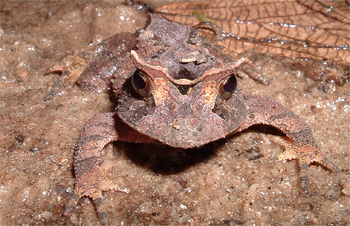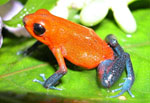Migrating frogs fare poorly when habitat altered
Migrating frogs fare poorly when habitat altered
mongabay.com
December 19, 2007
Habitat loss and fragmentation are putting amphibians already threatened by climate change, pesticides, alien invasive species, and the outbreak of a deadly fungal infection at greater risk of extinction, reported a study published in Science last week.
A team of Brazilian researchers identified “habitat split” — which they define as “human-induced disconnection between habitats used by different life history stages of a species” — as a key determinant of species richness decline in the Brazilian Atlantic Forest, a critically endangered ecosystem.
Many amphibians lay their eggs in water with offspring emerging as water-dependent larvae (tadpoles for frogs and toads). The young eventually grow into their adult form and move into forest areas. Habitat split occurs when the migration path between forest habitat and aquatic breeding grounds are disrupted by forest clearing or other human activities. Amphibians must then “make risky breeding migrations between suitable aquatic and terrestrial habitats”.
 Brazilian Horned Frog Proceratophrys boiei, a leaf-litter species with aquatic larvae that has been demonstrated to suffer with habitat split. In the background, we can see the wetness of its natural habitat, the Brazilian Atlantic Forest. |
“We found that habitat split negatively affects the richness of species with aquatic larvae but not the richness of species with terrestrial development,” wrote the authors. “This mechanism helps to explain why species with aquatic larvae have the highest incidence of population decline.”
“Adults of species with aquatic larvae, in order to breed, are obliged to abandon forest remnants to reach water bodies, and at the end of the reproductive season, both adults and juveniles are forced to locate and return to forest remnants,” the authors continued. “During this compulsory migration, they face multiple hazards that are associated with environmental conditions within the intervening matrix, such as dehydration, predation, agrochemicals, and other pollutants… In human-altered landscapes, habitat split can be
expected to reduce population sizes, decrease the extent and occupancy rates of metapopulations, and affect negatively the richness of local communities.”
The researchers say the findings help identify what species are potentially at greatest risk of extinction, while reinforcing the need to conserve and restore vegetation along waterways.
CITATION: Becker, C.G. et al (2007). Habitat Split and the Global Decline of Amphibians. Science Dec. 14, 2007
Related
Amphibian extinction may be worse than thought
(10/31/2007) Amphibian extinction rates may be higher than previously thought, according to new DNA analysis that found more than 60 unrecognized species in the Guiana Shield of South America.
 |
Forest disturbance reduces biodiversity in the Amazon rainforest
(7/2/2007) Two new studies in the Amazon rainforest show that plantation forests and second-growth forests have lower species counts for butterflies, reptiles, and amphibians than adjacent primary forest areas. The research has important implications for conservation of tropical biodiversity in a world where old-growth forest is increasingly replaced by secondary forests, industrial plantations, and agricultural landscapes.
 |
Scientists find possible cure for global amphibian-killing disease
(5/23/2007) Scientists have discovered a possible treatment for the fungal disease that has killed millions of amphibians worldwide. Presenting Wednesday at the General Meeting of the American Society for Microbiology in Toronto, Professor Reid N. Harris at James Madison University reported that Pedobacter cryoconitis, a bacteria found naturally on the skin of red-backed salamanders, wards off the deadly chytridiomycosis fungus, an infection cited as a contributing factor to the global decline in amphibians observed over the past three decades.
 |
Frogs avoid damaging UV-B radiation, reducing extinction risk
(4/18/2007) Poison arrow frogs appear to make special effort to avoid exposure to damaging ultraviolet-B radiation, according to research published in the journal Biotropica. The findings are significant in light of increasing levels of UV-B radiation due to ozone depletion.
 |
Bad news for frogs; amphibian decline worse than feared
(4/16/2007) Chilling new evidence suggests amphibians may be in worse shape than previously thought due to climate change. Further, the findings indicate that the 70 percent decline in amphibians over the past 35 years may have been exceeded by a sharp fall in reptile populations, even in otherwise pristine Costa Rican habitats. Ominously, the new research warns that protected areas strategies for biodiversity conservation will not be enough to stave off extinction. Frogs and their relatives are in big trouble.














